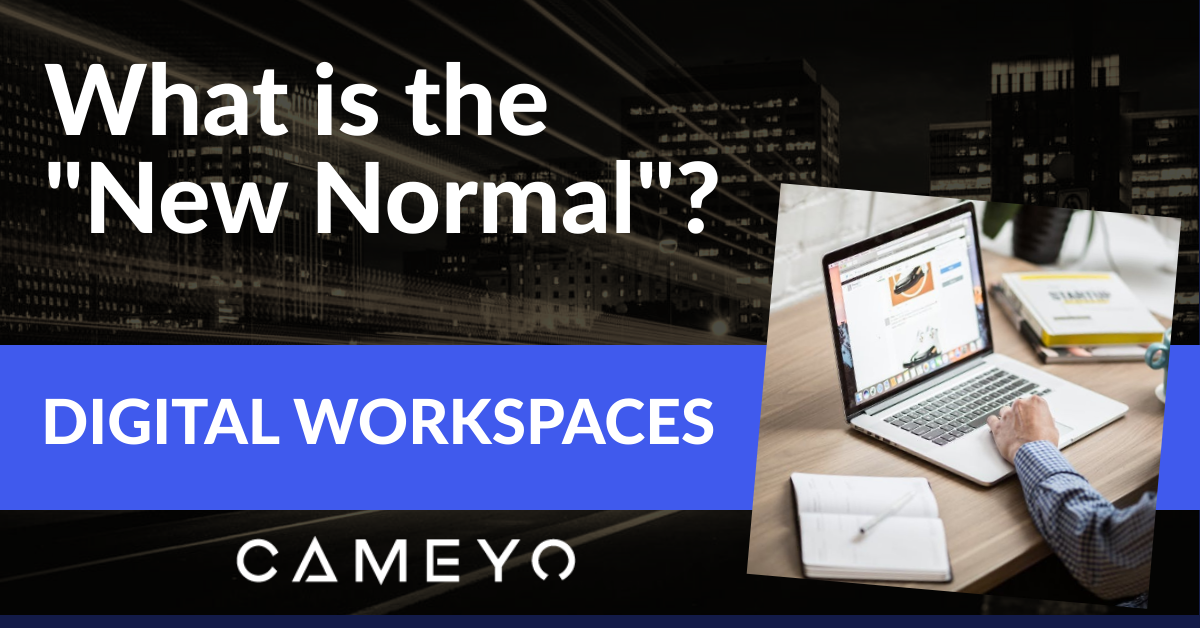Everywhere you turn these days, there’s someone else talking about the “New Normal.” In a world where all of our routines, processes, and realities have been turned upside down, it’s natural for people to want to put labels on things to help make sense of all of the change. 
We’re certainly no exception. We’ve been talking about the “New Normal” for months as a way to make sense of all of the changes organizations are currently undertaking to enable their people to be productive and their businesses to proceed despite the pandemic.
The primary issue is that everyone is using the “New Normal” terminology to describe different things. So in this post we will outline what the New Normal means in our vernacular, specifically when it comes to enabling people to be productive anywhere, from any device with Digital Workspaces.
No More “Us vs. Them”
Prior to the pandemic, most organizations viewed their employees as two separate groups – those who worked in an office (“internal” employees) and those who worked from home (“remote” employees). The two groups of employees had different needs when it came to technology, which meant IT had to establish two separate sets of requirements and tools.
For example, internal employees working on desktops in an office environment did not have to deal with VPNs since they were on the corporate network, whereas remote employees all had to rely on VPNs constantly to gain access to the resources they needed to be productive.
But now, a majority of employees are working remotely. And many companies have announced (and more do so daily) that they plan to make the option of working from home permanent.
Regardless of whether your people start going back into an office at some point or not, the old way of classifying employees has been demolished. There is no more “internal” vs. “remote” employee classification. In the new normal, there is simply the hybrid employee.
The Hybrid Employee
Currently, most employees continue to work from home. But eventually, many organizations do plan to at least partially re-open their offices. Organizations will handle bringing people back into the office in a lot of different ways, but for now it seems like many organizations will not be bringing people back into the office full time.
Here are a few of the different models that we’ve heard customers talk about, and that we’ve seen referenced in the news:
- Day In, Day Out – In this model, employees will only come into the office every other day to help limit their amount of exposure to co-workers.
- Rotations – In this model, there will be different groups of employees who rotate coming in on different days to help control density in the office and ensure proper distancing.
- As Needed – In this model, employees will primarily work from home as the default, and will only come into the office when truly needed.
Regardless of the model your organization chooses, one thing holds true – all employees will still need to be empowered to work from home at least part of the time.
So, What Does This Mean for IT?
A recent ESG survey and analyst report on the future of virtual desktops shows that there has been a big surge in deployment of virtual desktop infrastructure (VDI) and Desktop as a Service (DaaS) products to help deal with remote work. But it also reveals that those organizations who have adopted VDI/DaaS all report the same three issues – cost, complexity, and security.
As a result, the report indicates that legacy technologies like VDI and DaaS may not be the right long-term solution for enabling remote work at scale. Mark Bowker, Senior Analyst at ESG and author of the report says:
“With the dramatic increase in organizations that have enacted mandatory remote work policies, the demand for remote access to critical applications has skyrocketed. Organizations need solutions that can be deployed quickly and cost-effectively while also ensuring security. These survey results show that, despite the benefits of VDI and DaaS, those who have deployed those technologies continue to be challenged with the overall cost, management complexity, and security issues of those technologies.”
Which is why Digital Workspaces like Cameyo are disrupting the VDI and DaaS market. VDI is a bunch of pre-cloud technologies that must be deployed and managed by IT on-site to deliver a virtual desktop experience to their users. This requires significant investment in hardware and requires IT to manage servers, gateways, loads balancers, and other infrastructure. Desktop as a Service (DaaS) sought to ‘disrupt’ VDI by moving certain aspects of virtual desktop delivery to the cloud, but it still relies on the same costly and complex underlying infrastructure.
What IT needs to enable hybrid employees in the New Normal is a cloud-native Digital Workspace that enables the secure delivery of Windows and internal web apps to any device from the browser without the need for VPNs. Which is precisely what Cameyo was purpose-built to do. Cameyo provides a seamless, secure workspace for all Windows and internal web apps, enabling your remote and hybrid workers to be productive from anywhere.
Which is why Computerworld recently published a feature on Cameyo titled “Cameyo – the new alternative to Citrix.”
Regardless of whether you’re preparing now for the New Normal or looking for a Citrix alternative that can enable secure, cost-effective productivity for all of your hybrid employees, you can get started with a free trial of Cameyo today. Within minutes you can see how easy it can be to enable productivity from anywhere, on any device – regardless of what YOUR new normal looks like.
